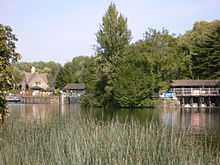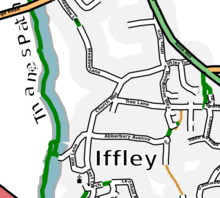Iffley
Coordinates: 51°43′52″N 1°13′37″W / 51.731°N 1.227°W
Iffley is a village in Oxfordshire, England, within the boundaries of the city of Oxford, between Cowley and the estates of Rose Hill and Donnington, and in proximity to the River Thames (Isis). Its most notable feature is its original and largely unchanged Norman church, St Mary the Virgin,[1] which has a modern stained glass Nativity window designed by John Piper. The church is listed Grade I.
History
"In the chronicles of Abingdon Abbey (AD 941 – 946) the place is called Gifteleia. The Domesday Book of 1086 it is Givetelei. Merton College records in the 1290s call it Iftele and Yiftele; it is Yeftley to the civil servants writing up the Domesday of Inclosures, in Latin, in 1517 – 18; Lincoln College accounts, written less formally and in English, have Ifley by 1543, and it is Iffley or Iflie during the Civil War 1642 – 46. Clearly, the sound of the name — at a time when spoken forms were dominant — was fixed by then. Afterwards the Y survived in occasional use, but only lawyers bothered with the T..."[2]
The ending of the name of this village near Oxford, means "cleared ground": the Old English term for that was "ley" — just up the road from modern Iffley, the town of Cowley also preserves the Old English ending and meaning in its name.
No records of the foundation of Iffley have been found, but the reason for its founding is clear from the location: Iffley has a little hill, and so is the first place downriver from Oxford from which traffic on the Thames might be surveyed, and controlled — and where people might be safe from floods:
"It is likely that the hill, running to 295 ft, now known as Rose Hill and Iffley, was a desirable place to live, safe from any floods. Many other villages, above and below, are set back from the river to cater for floods."[2]


During the 12th century Oxford townsmen built a watermill at Iffley, which was bought by Lincoln College, Oxford in 1445: the mill burned in 1908, having survived for nearly 800 years. Products ground at the Iffley mill included malt, barley, corn, and other cereals — for a brief time during the 15th century it was a fulling mill. The mill,
"…was notorious for its arguments between bargees and millers, who being in possession of the lock, whether it was a flash or pound lock, could preserve their head of water, and not let it flow down river, by opening the gates, as long as they wished."[2]
In 1156 Iffley was among the holdings of the Norman family of St. Remy, until about 1200. They established Iffley as a parish, and built the parish church, "in size and decorative splendour out of all proportion to the place".[2] The manor was owned by many, thereafter. The Archdeacons of Oxford were given the right to appoint the parish priest in 1279: they held this until 1965, when the power was given to the Dean and Chapter of Christ Church, Oxford.
Domesday Book entry
People mentioned: Abbey of St Mary of Winchcombe; Aelfgifu; Alnoth; Alric; Alwine; Azur; Bondi; Brian; Cynewig; Earl Tosti; Earl Aubrey de Coucy of Northumbria; Edwin the sheriff; Henry de Ferrers; Hugh; Hugh d'Ivry; Hugh de Bolbec; Queen Edith; Ralph; Robert; Roger; Rolf; Swein; Turold; Walter; Walter Giffard; William Peverel; William de Warenne; William fitzAnsculf. Date: 1086[3]
Notable people
- Frank Bickerton (1889–1954) Antarctic explorer and First World War aviator was born in Iffley.[4]
See also
The village of Iffley has given its name to:
- Iffley Church, the village church (aka St Mary the Virgin)
- Iffley College, the original name of Wolfson College
- Iffley Halt, a former station on the Wycombe Railway
- Iffley Lock on the River Isis
- Iffley Mill, locally famous for the spectacular fire that burnt it down in 1908
- Iffley Road in east Oxford
References
- ↑ Parish Church of St Mary the Virgin, Iffley
- ↑ 2.0 2.1 2.2 2.3 The Iffley History Society
- ↑ The National Archives Documents Online. Description. Place name: Iffley, Oxfordshire. Folio: 157v Great Domesday Book. Domesday place name: Givetelei
- ↑ 1891 Census of Headington District, RG11/1166, Folio 49, page 9.
Iffley History Society
Further reading
- Lobel, Mary D, ed. (1957). Victoria County History: A History of the County of Oxford: Volume 5: Bullingdon Hundred. pp. 189–206.
- Sherwood, Jennifer; Pevsner, Nikolaus (1974). The Buildings of England: Oxfordshire. Harmondsworth: Penguin Books. pp. 658–662. ISBN 0-14-071045-0.
| ||||||||||||||||||||||||||||||
External links
| Wikimedia Commons has media related to Iffley. |


